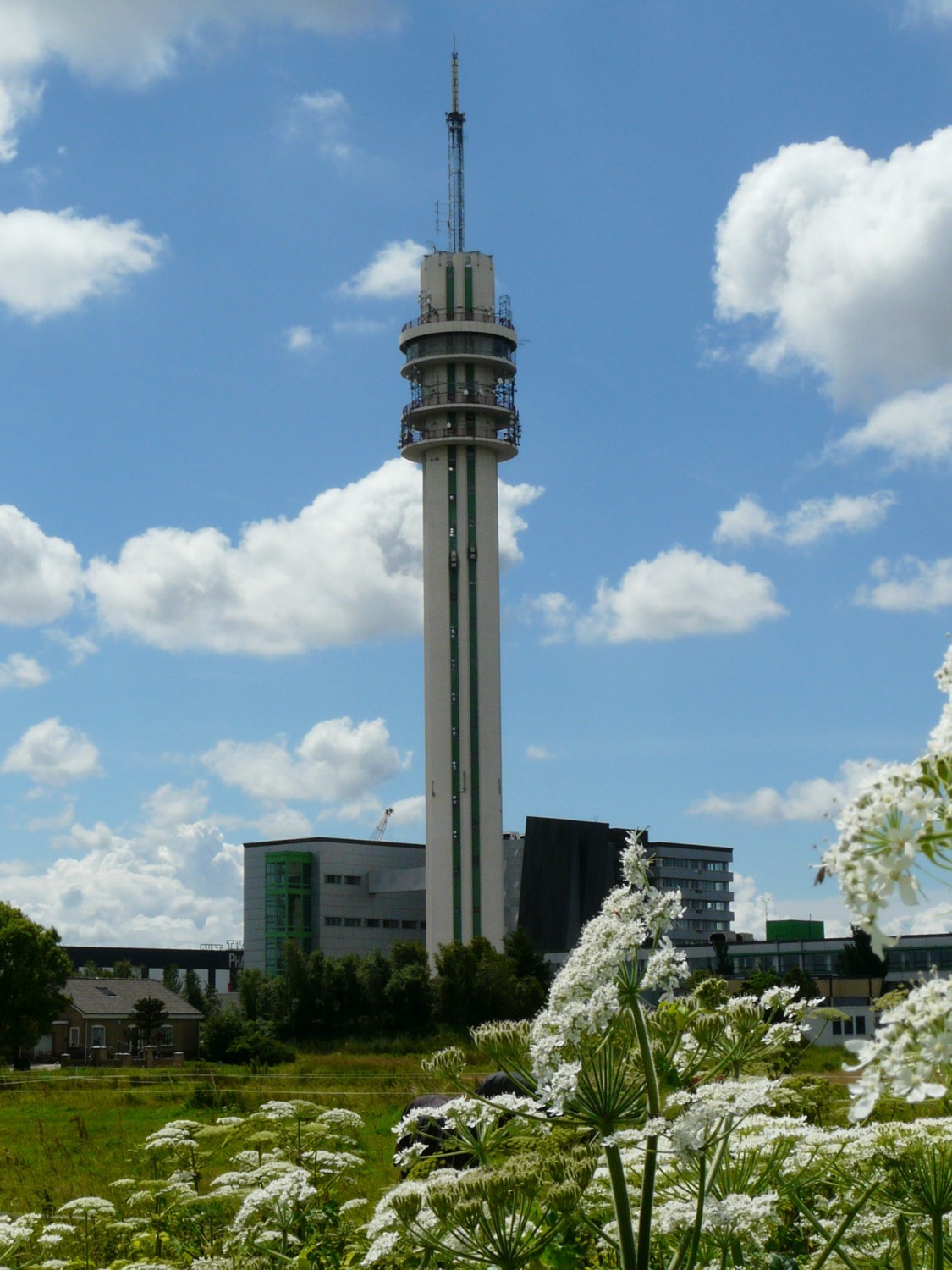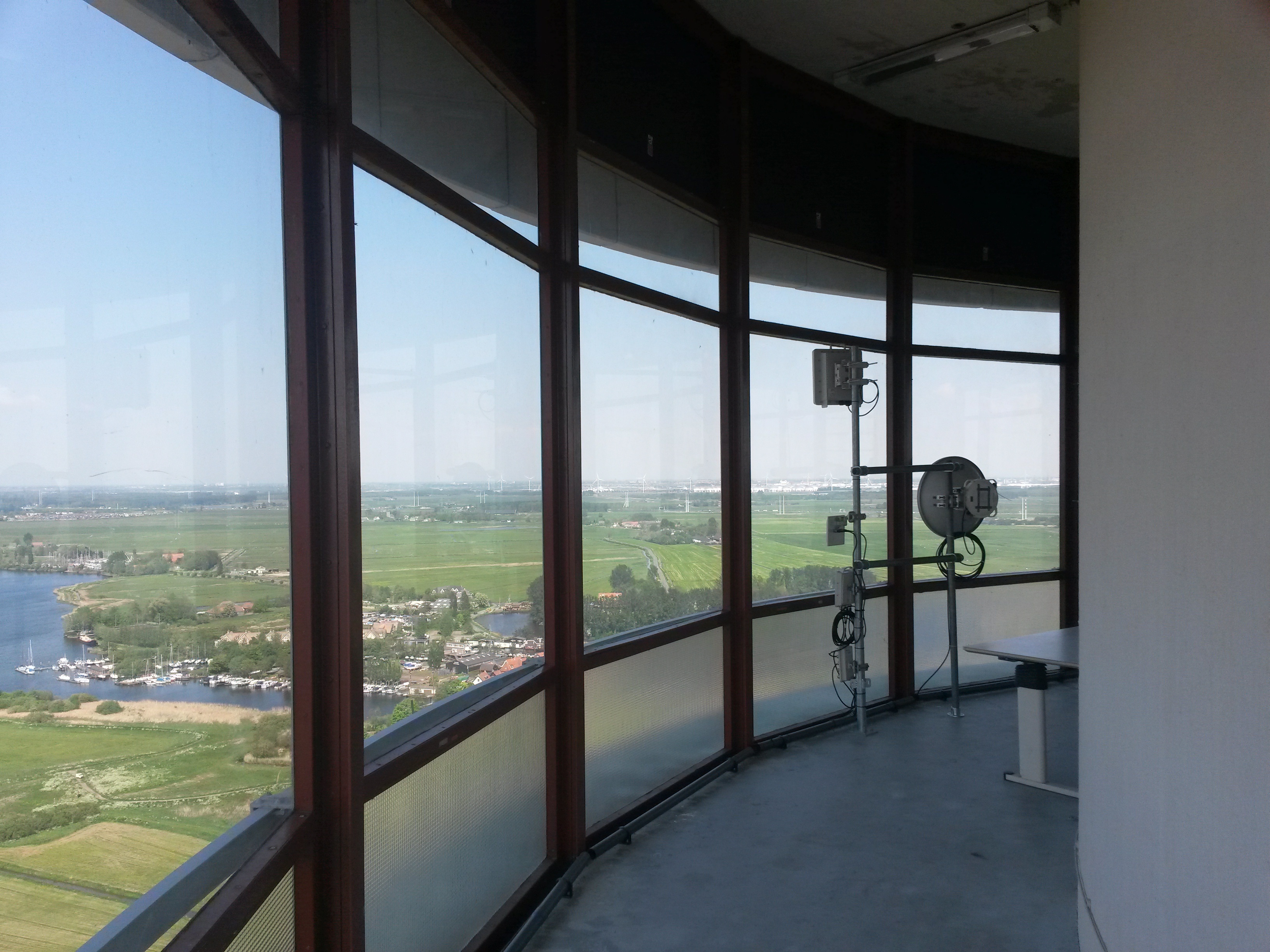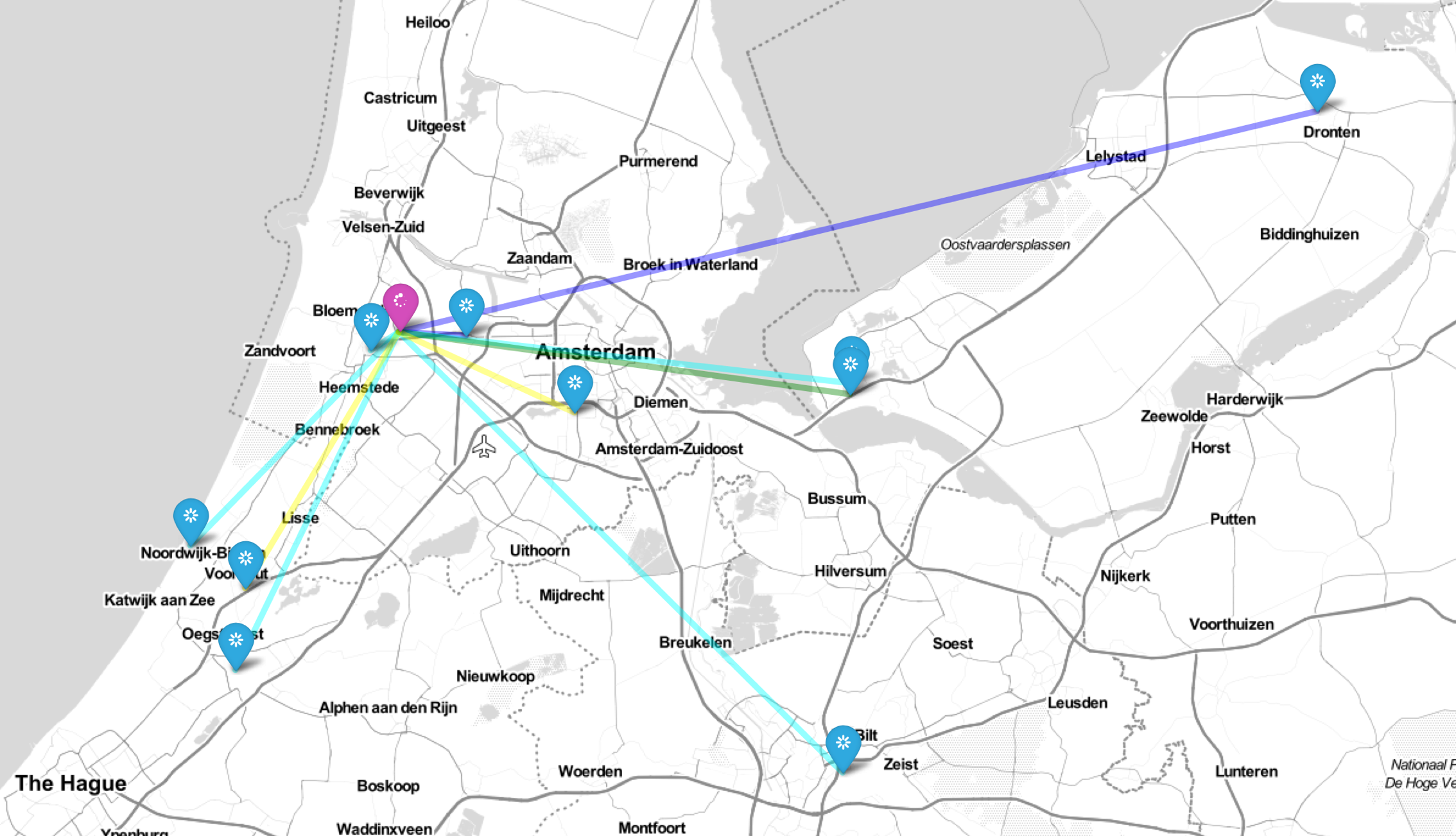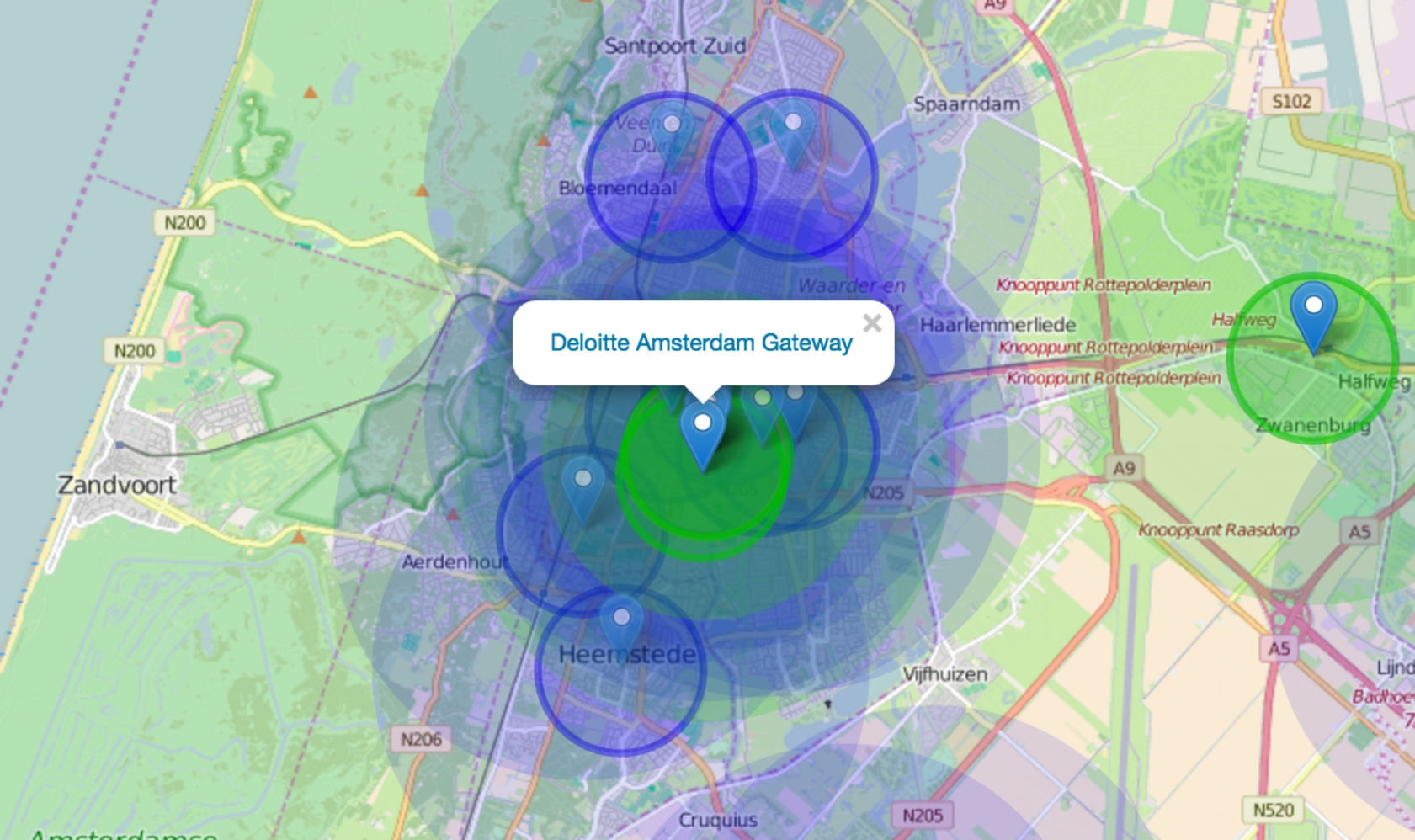I’m bringing some life to http://thethingsnetwork.org/c/haarlem …
@gerard_alticom invited us to the well-known Cellnex (formerly Alticom, formerly KPN/PTT) radio tower and data center in the Waarderpolder today, to discuss options to get a gateway installed at 95 meters.
As shown earlier by others, near line-of-sight situations with high altitude gateways/nodes can yield very nice ranges:



That is, an ESP8266/RFM95W node with a half wavelength dipole antenna, sending at SF7, SF9 and SF12, got its packets received at:
- Dronten, 0000024B080E00E0, 73 km, SF12
- Utrecht, AA555A00080605B7, 48 km, SF7/9/12
- Almere, 1DEE1EAE2E9F468B, 34 km, SF12
- Almere, AA555A0008060249, 34 km, SF7/9/12
- Oegstgeest, 1DEE04187DBF1BC6, 28 km, SF12
- Noordwijk, 008000000000A46D, 23 km, SF7/9/12
- Voorhout, FFFEB827EB6A415C, 23 km, SF12
- Amsterdam Buitenveldert, 008000000000B098, 15 km, SF12
- Zwanenburg, B827EBFFFEDFCD10, 5 km, SF9/12
- Haarlem, B827EBFFFF5FE05C, 3 km, SF12 (single channel gateway, SF12-only, 1st floor)
Note that at 95 meters altitude, if the gateways are at, say, 20 meters, line-of-sight propagation would limit the theoretical distance to 3.57 × (√95 + √20) ≈ 50 km. So, some funny tropospheric propagation may have helped.
And maybe some other gateways did not yet migrate to the new staging environment, which I used to get these results using the nice TTN Mapper. (Please use a recent version of the app, which allows for creating “experiments”, to avoid messing up regular coverage results!)
Gerard also reached a non-TTN Rotterdam gateway at 50+ km, SF12, using a simple quarter wavelength wire as an antenna.
Also, the municipality of Haarlem installed the first two Libelium Plug & Sense nodes this Monday. Try to find them 
Hi Arjan,
That is a very nice location.
Impressive distances you got from there.
Indeed, @nico1966a, nice distances. But unfortunately this also shows that higher might not always be better. (Or is it?) If this would have been a real node, and all its packets would be received by many gateways far away, then such might affect other nodes using the same frequency (channel) and spreading factor (SF; subchannel). And it would surely eat the capacity of those far-away gateways while there would be no actual need for that, if close-by gateways receive the packets too.
As such, I was surprised that even SF7 (fastest possible data rate, lowest air time, worst distance) was received 48 km away. I’d love to see what happens for nodes that are not that high, along with high altitude gateways. We “only” need someone to sponsor the gateway and location…
(Beware that nodes do not perform any activity nor collision detection; they just send when they feel like it. And there are only few rules to ensure every node should get its share.)
Cool, that is very impressive. Our Dronten gateway has been one of the best performing gateways so far, due to the surrounding (or actually: the lack of) clutter. I was a bit disappointed with the performance of the Almere West gateway, but here you show that line of sight is king (not considering capacity issues etc).
It would be nice if we could discuss some sponsoring by @gerard_alticom for the Lelystad location. That would nicely fill in the gap between Almere and Dronten and would provide Flevoland with instantaneous coverage into the agricultural area.
Note that my tests were not dedicated tests; I just took a node up into the tower when Gerard showed us around. I’ve been standing still at a few locations for a few minutes each time, to get at least one transmission out on SF7, SF9 and SF12 in a few directions. But the main goal was to get acquainted with Gerard and the tower; not to do the measurements.
Ah, someone took the Deloitte Kerlink gateway on a trip to Haarlem. Let’s keep it here; welcome! 

(And no, it’s not just the map that’s off; it received a packet I sent.)
Luckily most of the time the network is the other way around.
Gateways should be placed at perfect locations, nodes will be scattered around through town and in the fields.
The antenna is an important piece of both gateway and node, this includes antenna placement. Gateway antenna should be placed on a higher location outside to get a good range. Node antennas can not always be placed at an optimal location, the libelium node in the photo has the antenna very close to the metal lamp and shielded by the solar panel. Having it in front of the solar panel would most likely give a better range.
@Rob65, I’ve moved my thoughts/concerns to Best position for a gateway.
(And nice comments about that antenna being close to the metal pole!)
In April this year, Reshift Digital and the Dutch Java User Group organized the IoT Tech Days in Utrecht. That day, TTN presented one of the keynotes and along with Reshift Digital the IoT Lab Nederland was announced.
Now, Reshift is hosting a meetup in their Haarlem headquarters:
Oh yes, we’ve launched our own IoT Tech Community! We’re looking forward to welcome you at the very first IoT Tech Community Meetup on Tuesday the 5th of July at the Reshift Headquarters, Haarlem (the Netherlands). If you bring your knowledge, enthusiasm and curiosity along, we’ll take care of inspiring speakers, free food and drinks!
Meet you there? More information on meetup.com.
Seems it’s going to be a nice crowd; only 17 14 out of 100 places available for the IoT Tech Community in Haarlem this Tuesday.
Dear Haarlem members,
I also now have a single channel gateway running. It is really easy to make from a Raspberry Pi and an RFM92.
It is mainly for testing of my nodes, which is sometimes very difficult without nearby gateway.
But maybe others can use it too 
It will be replaced by a real gateway when the TTN Gateways become available.
Would someone be interested in something like this?
Hi!
Last friday I received my gateway and set it up in Hillegom.
I haven’t received my LoPy board yet so I haven’t been able to test if it is actually working.
What is the best thing to do once I get my board?
Create an application in TTN portal and try to send information to it?
Once that works, what is a good way to retrieve this information? A time based request to the API? or can the TTN portal send this information when it is received?
Yeps, create an application and a device within that application.
Connect your board via otaa or abp to ttn. You say you’ve got a LoPy coming in, but, if I remember correctly, there are some difficulties connecting it to TTN.
If messages are received by ttn, the will appear in the data-tab. But note that once you close the brwoser screen, the data is gone. TTN is just a pass throught, if you want the data to persist you should build something which does this.
Look at the ‘applications’ section of the docs. TTN makes an MQTT stream available in which every received message is being pushed to every listener.
Look at: https://www.thethingsnetwork.org/docs/current/mqtt/
If you want to check the connectivity of your gateway, look here.
Since Wednesday night, we’ve got a proper gateway in the city center:
Hi Arjan and all,
I received my first LoRa device last Saturday, the Pycom LoPy. From Velserbroek the only gateway I can reach is yours!
Unfortunately OTAA isn’t working, do you know it downlink is supported from your gateway?
I’ll be keeping an eye on this thread.
Joep
It’s a community gateway, and yes it’s a full-blown gateway that supports downlinks. (If you are unsure if the Join Request is actually accepted, then send me a private message when you’re testing, so I can peek in the gateway’s traffic.)
Thanks Arjan. Let me do some troubleshooting first on my side. I let you know how it goes.
Joep